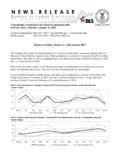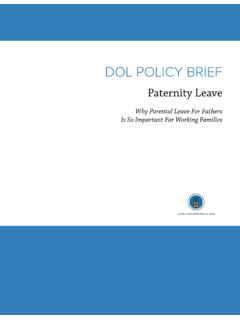Transcription of Aggregate Demand and Aggregate Supply - Economics
1 Aggregate Demandand Aggregate SupplyAdding Swingsin the Overall Price Levelto our Model of the EconomyOctober 23rd, 2019AS/AD Model: Links output changes to changes in the price level Powell driving the bus. Targeting output and prices. AE model looks only at output swings. How do changes in Demand affect Aggregate output and the price level? How do changes in supplyaffect Aggregate output and the price level? How do changes in the price level affect Aggregate demandand Aggregate output?A Downward Sloping ADCurve:(As the overall price level falls, the level of output rises) Is it due to the Substitution Effect? Demand curves, for specific goods, are downward sloping: As we travel down a Demand curve we discover:the quantity demanded rises, as the price fallsASSUMING ALL OTHER PRICES ARE STABLE!
2 When the price of the good falls people buy more,Because the good is now CHEAPER THAN OTHER GOODS A micro example, Demand curves working, for an individual market. Microeconomic theory teaches us:When the price of an individual good falls, Demand rises (the law of Demand ). If the price of solar power falls, and the price of oil and coal stay the same, the Demand for solar power will rise. We substitutesolar power for coal power, due to the fall in the price of solar AD Curve: Substitution EffectsCannot Explain the Downward slope of the AD Curve The Aggregate Demand Curve depicts the effects on OVERALL Demand , given a change in the PRICES OF ALL GOODS AND SERVICES. Clearly substitution of one good for another cannot explain a shift in overall Demand given a shift in overall prices.
3 Why Does the Aggregate Demand Curve Slope Downward?(Why Is a Fall in the Overall Price Level, Associated with Higher Output?) The Wealth Effect: Household consumption is most strongly determine by income, but it is also affected by household wealth is held in nominal assets; so as price levels rise, the real value of household wealth declines. This results in less consumption. The Interest Rate Effect: When prices rise, households and firms need more money to finance buying and selling. This increase in Demand for money causes the price of holding money (the interest rate) to rise, discouraging firm investment. The Wealth Effect: Ernie has SAVED $20,000, held in a local bank. A moped cost $8,900. A 12 foot flat screen TV costs $9,200. A vacation to Paris for a month cost $9,700.
4 He contemplates buying two of these three items, after graduation. Prices, however, leap(inflation is 20%, in 2018). New prices:Moped=$10,680 TV=$11,040 $11,640 Ernie now can buy only one of the Interest Rate Effect(theoretical) Households keep their financial wealth in various places: cash, bonds, stocks Households hold enough cash to make it easy to pay their bills If prices jump, households must sell some bonds and stocks to increase their cash holdings Sell bonds, prices fall, interest rates rise Higher interest rates means less investmentThe Interest Rate Effect Explained(A Sesame Street Example) Bert, Ernie, Big Bird, Miss Piggy and the Count all keep , on average, $5,000 in their checking account, to pay bills. Prices fall(inflation is -1% in 2015) They each decide they only need $3,000 in their accounts now, to pay bills.
5 They all buy bonds, the prices rise, and yields fall. The lower real interest rates boosts home building. A movement along the AD Curve:the price level falls and output risesA shift in the AD Curve:AE Model to AD-AS Modela simple derivation Our AE model assumes the overall price level is reflects our assumption that there is enough capacity to increase output We relax that assumption. Prices jump from period 1 to period 2 The AE line falls, at any level of output less in demanded. Equilibrium is now lower. Thus we can derive the AD line, by manipulating our AE modelThe AE Model: Embedded in the AD-AS ModelSuppose inflation jumps. The price level rises to 110, from 100. Wealth effect and interest rate effect push down AE, for a given level of Y (AE1 falls to AE2)at P = 100, equilibrium level for Y = Y1at P = 110, equilibrium level for Y = Y2, lower than Y115of 47 2013 Pearson Education, Inc.
6 Publishing as Prentice HallThe AD curve: relationship between the price level and real GDP demanded, holding everything else change in the price level not caused by a component of real GDP changing results in a movement along the AD change in some component of Aggregate Demand , on the other hand, will shift the AD of the AD curve, vs. movements along it16of 47 2013 Pearson Education, Inc. Publishing as Prentice HallBudget policy: The White House and the Congress can choose to increase spending or cut taxes, as they did late in 2017. Other things equal, this will raise Demand as it shifts the AD curve contrast, Senate Majority Leader Mitch McConnell s recent calls to cut social security and Medicare payments, other things equal, would cause the AD curve to shift inward.
7 AD shifts: changes in fiscal policyTable the Aggregate A decrease in spending Demand curve inward 17of 47 2013 Pearson Education, Inc. Publishing as Prentice HallMonetary policy: Chair Powell at the Federal Reserve can choose to change interest rates, (think Phillips Curve) to pursue macroeconomic policy the Federal Reserve lifts interest rates, investment spending falls;if the Fed lowers interest rates, investment spending shifts: changes in monetary policyTable the Aggregate An increase Demand 47 2013 Pearson Education, Inc. Publishing as Prentice HallTrump promises a business friendly environment: Households or firms become more optimistic about the future, increasing consumption or investment Korea bombs Guam, The opposite would clearly shifts: changes in expectationsTable the Aggregate An increase Demand 47 2013 Pearson Education, Inc.
8 Publishing as Prentice HallBrazil and many emerging economies, in 2015, fell into incomes and spending shrunk. Their imports of goods s exchange rate fell sharply. exports became more expensive, so foreigners bought less of them (and we bought more imports, also).AD shifts: think 2015 Developing World vs. USAT able the Aggregate An increase Demand change in the real net exports in 2016-2019Q2:Subtracted from real GDP21of 47 2013 Pearson Education, Inc. Publishing as Prentice HallAggregate Supply refers to the quantity of goods and services that firms are willing and able to relationship between this quantity and the price level is different in the long and short we will develop both a short-run and long-run Aggregate Supply Aggregate Supply curve: A curve that shows the relationship in the long run between the price level and the quantity of real GDP Supply and time frame22of 47 2013 Pearson Education, Inc.
9 Publishing as Prentice HallIn the long run, the level of real GDP is determined by the number of workers, the level of technology, and the capital stock (factories, machinery, etc.).None of these elements are affected by the price Aggregate Supply curveFigure the long-run Aggregate Supply curve does not depend on the price level; it is a vertical line, at the level of potentialor full-employment vertical long run Supply curve: You can t get more output if you allow more inflationThe same concept as the Phillips Curve: there is no LONG RUN inflation/unemployment tradeoff In the short run, there is evidence that an economy can produce more stuff, if you ignore a rising price level. Chair Powell, driving the bus, could say, to hell with high inflation, I ll accept it to get stronger growth and lower unemployment.
10 But the LONG TERM trajectory for output cannot be lifted by allowing prices to rise we learned:LTSG = % in Labor Productivity + % in Labor ForceThe Short run Aggregate Supply Curve:Why is it Upward Sloping? Who provides us with the output(the Supply )?FIRMS What drives firm decisions?PROFITS The Simplest Profits formula?Profits = Revenues -Costs Profits per item sold Profits = Revenues -Costs Profits/pizza = (Revenues/pizza) (Cost/pizza) Revenues/pizza = the price of the pizza Cost/pizza: 80% are labor costs (wages)Wages are stickyif the price level is rising, and wages are sticky, you make more money per unit soldIf you make more money/unit,why do you increase production? Same question as, why do Supply curves slope upward? Pizza s cost is largely the labor cost to make pizza At $15 per pizza I makemoney with 5workers At $15 per pizza I losemoney with 8 workers At $20 per pizza I makemoney with 8 workersIf I can raise my prices and not pay my people more,I find its profitable to make more pizza(Note: with 8 workers, labor costs per pizza rise to $ , up from $ ) pizzas cost pernon labor totalprofit# of# ofsoldworkercosts pertotal non-labortotal price percost peror loss ovensworkersper dayper daypizza per daylabor costscostscostspizzapizzaper pizza1550$80$2$400$100500$ $ $ $ $80$2$640$130770$ $ $ ($ )1865$80$2$640$130770$ $ $ $ 47 2013 Pearson Education, Inc.









